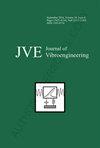基于多项式拟合的水平轴风力涡轮机叶片霜冰形成方法
IF 0.7
Q4 ENGINEERING, MECHANICAL
引用次数: 0
摘要
本文提出了一种新的直接计算水平轴风力发电机叶片表面霜冰形状的方法。利用线性插值算法,将 LEWICE 2D 软件或冰风洞实验得到的翼面冰形在第一和第四象限拟合等距步长,在第二和第三象限拟合等距步长。通过数学降维,将横截面上沿跨度方向的冰形关键点坐标分别映射为滞后面和拍击面。采用多项式拟合方法处理滞后面和拍击面上多个断面的冰投影点,进而得到叶片的结霜冰形。通过计算同一极角下的极径残差平方和,分析了实验法与机翼霜形拟合法、实验法与 FENSAP、叶片霜形形成法与 FENSAP 之间的误差。结果表明,新方法与 FENSAP 仿真结果和实验结果的冰形吻合良好。残差平方和很小。该方法使得风电叶片霜冰形态分析无需考虑跨学科因素。计算过程简单可靠。本文章由计算机程序翻译,如有差异,请以英文原文为准。
A frost ice formation method of horizontal axis wind turbine blade based on polynomial fitting
In this paper, a new direct calculation method of frost ice shape on the blade surface of horizontal axis wind turbine is proposed. Using linear interpolation algorithm, the airfoil ice shape obtained by LEWICE 2D software or ice wind tunnel experiment was fitted with equidistant step length in the first and fourth quadrants and equidistant step length in the second and third quadrants. The key point coordinates of ice shapes on cross-sections along the span-wise were mapped into lagging and flapping surfaces through the mathematical dimension reduction, respectively. The polynomial fitting was used to deal with ice projection points of multiple sections in lagging and flapping surfaces, and then the blade’s frost ice shape was obtained. By calculating the sum of squared residuals of the polar diameter at the same polar angle, the errors between experimental and airfoil frost shape fitting methods, experimental and FENSAP, and blade frost shape formation methods and FENSAP were analyzed. The results show that the new method is in good agreement with the ice shape of FENSAP simulation results and experimental results. The residual sum of squares is small. This method makes the analysis of frost ice morphology of wind turbine blades do not need to consider interdisciplinary. The calculation process is simple and reliable.
求助全文
通过发布文献求助,成功后即可免费获取论文全文。
去求助
来源期刊

Journal of Vibroengineering
工程技术-工程:机械
CiteScore
1.70
自引率
0.00%
发文量
97
审稿时长
4.5 months
期刊介绍:
Journal of VIBROENGINEERING (JVE) ISSN 1392-8716 is a prestigious peer reviewed International Journal specializing in theoretical and practical aspects of Vibration Engineering. It is indexed in ESCI and other major databases. Published every 1.5 months (8 times yearly), the journal attracts attention from the International Engineering Community.
 求助内容:
求助内容: 应助结果提醒方式:
应助结果提醒方式:


